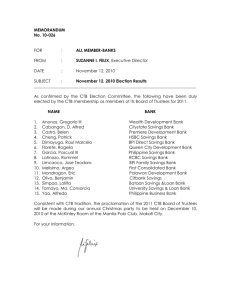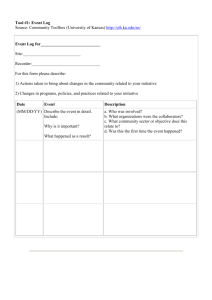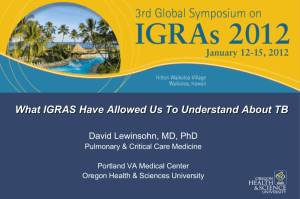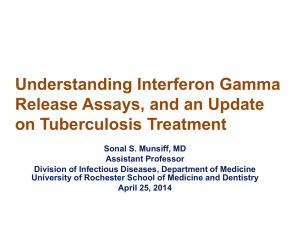Clemax Sant' Anna's presentation
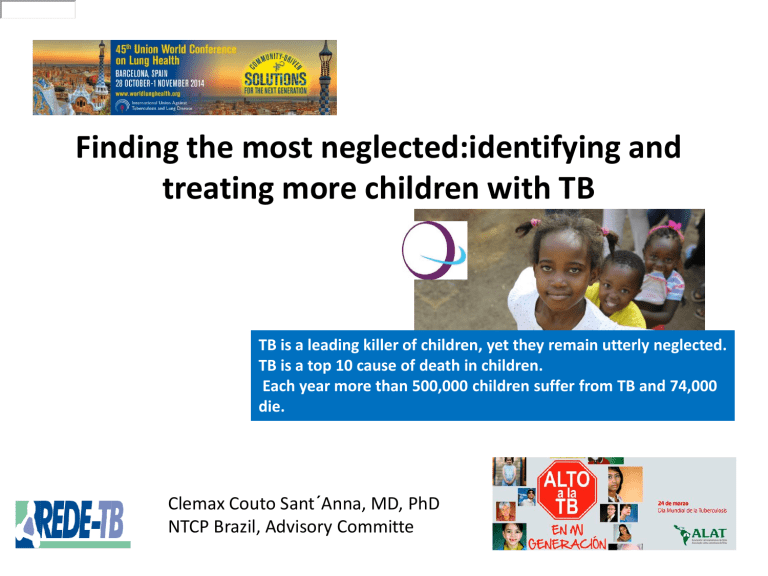
Finding the most neglected:identifying and treating more children with TB
TB is a leading killer of children, yet they remain utterly neglected.
TB is a top 10 cause of death in children.
Each year more than 500,000 children suffer from TB and 74,000 die.
Clemax Couto Sant ´ Anna, MD, PhD
NTCP Brazil, Advisory Committe
Actions to improve TB care
WHO and the Stop TB Partnership point to 3 key actions needed to improve TB care and prevent
TB deaths in children
• Detection and management of children with TB
• Detect active
TB and latent
TB
• Prevention
Trained
Health workers
Contact tracing and IPT
New (and
“old”) diagnostic tools
• Diferences between TB in children & adolescents
PREVENTION: Tuberculin skin testing & IGRAS
Easy training
Can be used in serial tests
(repeated tests) – PLWHA contacts, health professionals
Evidence of benefit of IPT among positive TST people
Needs 1 visit for result - lost cases
Lab is not necessary
“Indetermined” results
Yes
No
Yes
No
TST
Yes
Yes
PNCT. MS- Brazil, 2014
IGRAS
No
No
??
Yes
No
Indetermined (~2%) results; in a Brazil study : 27%
PREVENTION: Tuberculin skin testing & IGRAS
Tub
Easy training
Can be used in serial tests (repeated tests) – PLWHA contacts, health professionals
Evidence of benefit of IPT among positive TST people
Needs 1 visit for result - lost cases
Lab is not necessary
“Indetermined” results
Yes
No
Yes
No
TST
Yes
Yes
IGRAS
No
No
??
Yes
No
Indetermined (~2%) results; in a Brazil study : 27%
DIAGNOSIS: Specimen collection methods
Nasopharyngeal aspiration
Bronchoalveolar lavage
Sputum induction
Gastric aspiration
String test
Stool
Lynph node fine needle aspiration
Guidance on approach to diagnosis of TB in children
(WHO. Guidance, 2nd ed,2014)
• Careful history (including history of TB contact and symptoms consistent with TB)
• Clinical examination (including growth assessment)
• Tuberculin skin testing
• Chest X-ray (if avaliable)
• Bacteriological confirmation whenever possible
• Investigations relevant for suspected PTB and suspected EPTB
• HIV testing
WHO. Guidance for NTP on the management of TB in children, 2014
Pulmonary TB in children and adolescents
Diferences
Children - Primary TB
Clinical signs & sintoms, contact, X rays , TST.
Diagnostic Score
Adolescents - Adult type
TB
Clinical and bacteriological (or molecular) assessment.
Xpert
Score system for diagnosis of pulmonary TB in children
(and negative adolescents).MOH-Brazil
Scores for Childhood TB dianosis.
Sistematic review, 2012
Scores and systems
Kenneth Jones
Ghidey & Habte
Keith Edwards
WHO (Tdjani et al)
IUATLD
MOH Brazil
(Pulmonary TB)
Statistics
S- 56%
Sp – 73% - 95 %
S- 51.6 – 100%
S – 62% - 88%
Sp – 25 – 97%
S – 0%
Sp – 100%
S < 70%
Sp < 70%
Cutt-off ≥ 30 points
S – 88,9 – 99,3%
Sp – 70 - 86,5%
Cutt-off ≥ 40 points
S – 40 - 58%
Sp – 85 - 98 %
Pearce EC et al. Aids Res Treat
2012; 4018
Gene Xpert
Diagnosis of paediatric TB in Community-based TB services
Rio de Janeiro, Brazil. 2014
Period: Aug- Sept 2014
Children Adolescents
Total
8/68 (11. 8 %)
(n/suspected cases)
1 (1.5%)
RMP resistanceᴓ
J. Pio - SMSDC . Rio de Janeiro, Brazil
7 (10.2%)
Finding the most neglected: identifying and treating more children with TB
Development of national leadership in adrressing CTB and working groups focusing on CTB
Situation analyses and identification of national priorities for implementation Inclusion of CTB in reviews and monitoring missions led by NTBCP
Implementation and evaluation of training activities relating to
CTB
Integrating CTB into
Community-based child health care
Development of clinical guides/national guidlines for managing CTB
ROADMAP FOR CHILDHOOD TB, 2013
(adapt).
